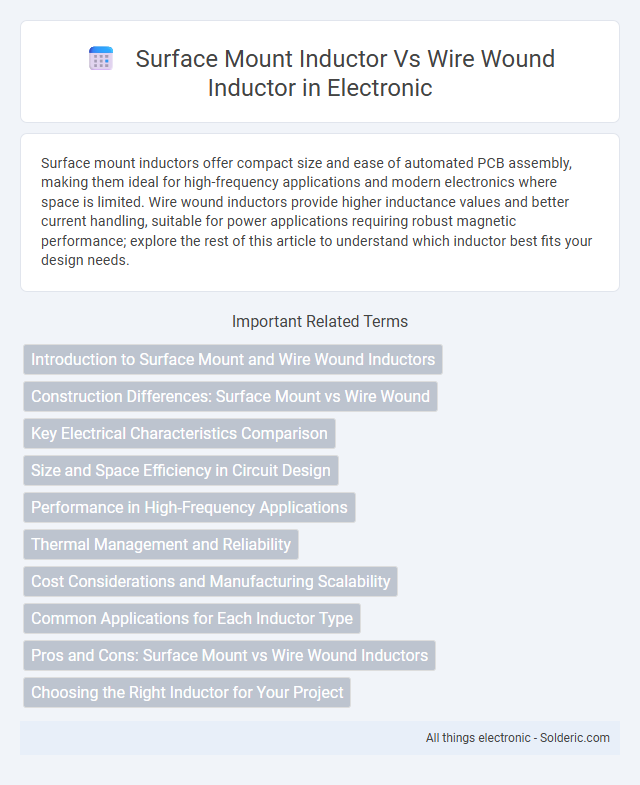Surface mount inductors offer compact size and ease of automated PCB assembly, making them ideal for high-frequency applications and modern electronics where space is limited. Wire wound inductors provide higher inductance values and better current handling, suitable for power applications requiring robust magnetic performance; explore the rest of this article to understand which inductor best fits your design needs.
Comparison Table
| Feature | Surface Mount Inductor | Wire Wound Inductor |
|---|---|---|
| Mounting Type | Surface Mount Technology (SMT) | Through-Hole Technology (THT) or SMT |
| Size | Compact, ideal for high-density PCB layouts | Larger, bulkier due to wire coils |
| Inductance Range | Typically low to medium (nH to mH) | Wide range, from mH to several mH |
| Current Rating | Moderate current handling | High current capability |
| Power Loss | Lower core and copper losses at high frequency | Higher losses, especially at high frequency |
| Frequency Performance | Optimized for high-frequency applications | Better for low-frequency and high power |
| Durability | Less mechanical strength, sensitive to soldering stress | Robust, durable with strong mechanical structure |
| Cost | Generally lower cost for mass production | Higher manufacturing cost |
| Applications | Mobile devices, RF circuits, compact electronics | Power supplies, transformers, audio equipment |
Introduction to Surface Mount and Wire Wound Inductors
Surface mount inductors are compact, designed for automated PCB assembly with high-frequency applications, offering low profile and excellent performance in space-constrained electronic devices. Wire wound inductors consist of coils wrapped around a core, providing higher inductance values and superior current handling, commonly used in power supplies and RF circuits. Understanding your application's size constraints and electrical requirements helps determine whether a surface mount or wire wound inductor is the ideal choice.
Construction Differences: Surface Mount vs Wire Wound
Surface mount inductors feature a compact, flat construction with coils embedded inside a magnetic core, optimized for automated PCB assembly and high-frequency applications. Wire wound inductors consist of copper wire tightly wound around a magnetic or non-magnetic core, providing higher inductance values and superior current handling capabilities. The difference in construction influences electrical performance, size, and suitability for specific circuit designs in electronics manufacturing.
Key Electrical Characteristics Comparison
Surface mount inductors typically offer lower resistance and higher frequency performance due to their compact design and precise manufacturing, resulting in reduced power loss and improved efficiency in high-frequency circuits. Wire wound inductors generally exhibit higher inductance values and current handling capability, with better saturation characteristics, making them suitable for applications requiring robust energy storage and filtering. The choice between these inductors hinges on balancing factors like inductance range, current capacity, frequency response, and size constraints in electronic circuit design.
Size and Space Efficiency in Circuit Design
Surface mount inductors offer superior size and space efficiency compared to wire wound inductors due to their compact, low-profile design ideal for high-density circuit boards. Wire wound inductors, being bulkier with exposed coils, occupy more space and are less suitable for miniaturized electronics. Designers prioritize surface mount inductors in applications where maximizing board real estate and reducing component height are critical factors.
Performance in High-Frequency Applications
Surface mount inductors excel in high-frequency applications due to their low profile, minimal parasitic capacitance, and efficient heat dissipation, which reduce signal losses and maintain inductance stability. Wire wound inductors, while offering higher inductance values, often exhibit increased parasitic capacitance and core losses at elevated frequencies, negatively affecting performance. Advanced surface mount designs with ferrite cores optimize impedance characteristics, making them preferable for RF circuits and high-speed digital signals.
Thermal Management and Reliability
Surface mount inductors offer superior thermal management due to their compact design and efficient heat dissipation across the PCB, reducing hotspots and enhancing system reliability in high-frequency applications. Wire wound inductors provide higher current handling and thermal stability through their robust coil construction, but their larger size can lead to localized heating issues impacting long-term reliability. Optimizing thermal performance in surface mount inductors relies on PCB layout and material choice, while wire wound inductors depend on coil design and heat sinking to maintain operational reliability under varying thermal loads.
Cost Considerations and Manufacturing Scalability
Surface mount inductors offer lower manufacturing costs and higher scalability due to automated assembly compatibility and reduced material usage compared to wire wound inductors, which often incur higher labor and material expenses. Wire wound inductors provide customizable inductance values and power handling but face limitations in mass production efficiency and process automation. Cost-effectiveness and large-scale production favor surface mount inductors in high-volume electronics manufacturing.
Common Applications for Each Inductor Type
Surface mount inductors are commonly used in compact electronic devices such as smartphones, laptops, and wearable technology due to their small size and ease of automated assembly. Wire wound inductors are preferred in power supplies, audio equipment, and RF circuits where higher current handling and superior inductance stability are critical. Your choice depends on the specific requirements of size, current capacity, and frequency performance in your application.
Pros and Cons: Surface Mount vs Wire Wound Inductors
Surface mount inductors offer compact size, high-frequency performance, and automated assembly compatibility, making them ideal for modern electronics, but they often have lower current capacity and thermal dissipation compared to wire wound inductors. Wire wound inductors excel in handling higher currents with better inductance precision and superior heat dissipation, yet they are bulkier and less suitable for automated surface mount technology (SMT) assembly. Your choice depends on balancing space constraints and electrical requirements, favoring surface mount for miniaturization and wire wound for robustness.
Choosing the Right Inductor for Your Project
Surface mount inductors offer compact size and ease of automated assembly, ideal for high-frequency and space-constrained applications. Wire wound inductors provide higher current capacity and superior magnetic performance, making them suitable for power management and audio applications. Your choice depends on balancing size, electrical requirements, and manufacturing processes to optimize circuit performance.
Surface Mount Inductor vs Wire Wound Inductor Infographic

 solderic.com
solderic.com